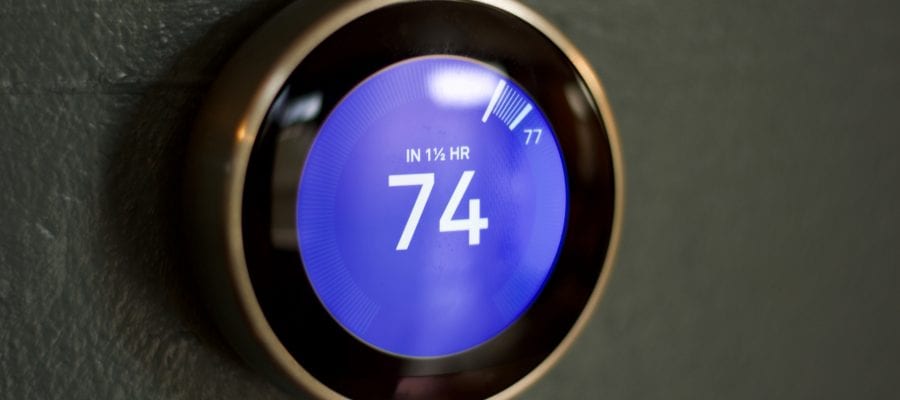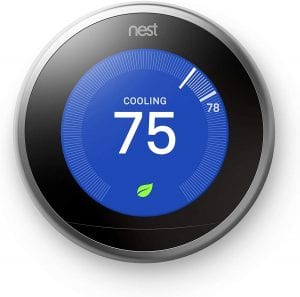The Best Smart Thermostat

Our Review Process
Don't Waste Your Money is focused on helping you make the best purchasing decision. Our team of experts spends hundreds of hours analyzing, testing, and researching products so you don't have to. Learn more.
Our Picks For The Top Smart Thermostats
- 1. Nest Learning Smart Thermostat
- 2. Honeywell Color Touch Smart Thermostat
- 3. Honeywell Home Wi-Fi Smart Thermostat
- 4. Mysa Smart Thermostat
- 5. Emerson Sensi Touch Smart Thermostat
- 6. ecobee lite Smart Thermostat
- 7. Honeywell Color Wi-Fi Smart Thermostat
- 8. Emerson Sensi Touch Wi-Fi Smart Thermostat
- 9. GoControl Smart Thermostat
There's no need to schedule the Nest Learning Smart Thermostat. It learns your preferences and automatically adjusts the temperature throughout the day. Due to its popularity, it's compatible with a wide range of smart home devices, including Google Assistant and Alexa.
Most Energy SavingThe Nest Learning Smart Thermostat not only learns your preferences, but it displays a leaf when your system is at an energy-saving temperature.
An easy-to-use app sets the Honeywell Color Touch Smart Thermostat apart from competitors, letting you control your device from a smartphone or computer. This Honeywell thermostat also uses data from local utility companies to determine peak hours and adjust your thermostat, saving you money on heating and cooling. If you need more than one thermos...
Best Remote AccessUsing the app, you can control the Honeywell Color Touch Smart Thermostat from wherever you are.
From the time it's installed, your Honeywell Home Wi-Fi Smart Thermostat will be on a schedule, which you can use or customize to fit your own household's needs. You'll also get compatibility with a wide range of system types. If the power goes out, the thermostat will remember your settings and resume its programmed activity as soon as you're back...
Best for Manual SchedulersThe Honeywell Home Wi-Fi Smart Thermostat has scheduling features that make it easy to control the temperature throughout your home.
Buying Guide
When they first came along, programmable thermostats seemed like a great way to save money on electricity when you weren’t at home. However, many consumers find that they don’t keep the same hours day after day, week after week. When schedules do change, adjusting things takes extra work that they may not want to put in.
Enter learning thermostats. These innovative devices monitor the activity within your home and automatically adjust the temperature as needed. As you start shopping, though, you’ll find that many learning thermostats also have the option to control the temperature using an app or controls on the wall box itself. But as “On The Fly…DIY” writer, producer and narrator Vicki Liston says, this automation can be tricky, so it’s important to choose the right type of smart thermostat.
“I recommend shopping for a smart thermostat that uses both a motion sensor and geo-fencing input to determine settings,” Liston says.
Accuracy also relies heavily on where the thermostat is placed inside your home. Like other types of thermostats, a smart thermostat should be mounted on an inside wall, approximately five feet above the floor.
“Install your smart thermostat in a place where there is no direct sunlight from nearby windows or doors and where it is not in the path of a vent,” Liston says. “Sunlight and drafty locations can cause false temperature readings and the thermostat will not be able to operate as efficiently as it should.”
Liston also reminds shoppers that some thermostats let users set up alerts. You can set your thermostat to notify you that it’s time to change your furnace filter or schedule maintenance with a local heating and air provider.
Before you start shopping, though, note the type of unit you have. Not all thermostats will work with all systems, so you can save time by buying the right product from the start. You’ll find most often you see thermostats that are compatible only with electric heating, which means they won’t work with furnaces. Still other thermostats are universal in nature, but even with those, check to make sure they’re compatible with your system before making your purchase.
Our Expert Consultant

Home Improvement Expert
Vicki Liston writes, produces, and narrates “On The Fly…DIY,” an award-winning home improvement and DIY show of unique project tutorials for the casual DIY’er.
Home improvement and all things DIY have been Liston’s passion since she bought her first house in 2007 and she started making video blogs in 2014. She’s performed hundreds of DIY projects, from small ones to major, wall-smashing renovations and can teach you how to make a trendy DIY barn door for cheap. The proceeds earned from “On The Fly…DIY” are donated to no-kill animal shelters and rescue organizations.
What to Look For
- Your thermostat’s display will likely serve as the primary source of information for your household. Some thermostats have larger displays than others, but also look for a higher resolution and easy-to-read text.
- A thermostat will typically blend with your home’s décor, but make sure you choose one that has the look you prefer. Some have the round design found in pre-digital thermostats, while others take on the boxy look that has become popular in more recent years. You’ll also find some let you change up the color of the screen or come with colored rings.
- With rare exceptions, you’ll probably need help or wiring expertise to install your thermostat.
“Traditional thermostats could maintain operation on a small battery or low voltage wires, but smart thermostats need a constant source of power from the ‘C wire’ or common wire,” Liston says. “If you are unsure if your current wiring set up has the C wire, please check with a qualified HVAC person. Incorrect wiring can result in damage to both the thermostat and your heating and cooling system.”
- Voice control is one of the best “extras” included in smart thermostats. If you have an Alexa or Google Assistant speaker, make sure you choose a smart thermostat that works with it. You’ll be able to raise or lower the temperature by simply speaking the command.
- Smart thermostats can get a little complicated, so pay close attention to the design of the thermostat you choose. The more minimal the design, the better, especially if you choose a thermostat that monitors your household activity and adjusts accordingly. However, if you prefer to be more hands on with your temperature control, make sure you have a thermostat that makes it easy to set a schedule or adjust throughout the day.
- Smart thermostats aren’t inexpensive, but be sure as you price them, you consider whether you’ll need multiple thermostats for your home. Some thermostats let you set up separate zones, which could save you money.
- Most smart thermostats let you control your home’s temperature remotely using an app. You’ll need to choose a thermostat with an app for the type of devices you’ll be using for this control, whether it’s an iOS, Android or other mobile operating system. Some thermostats will even let you control them from a computer.
- Scheduling is an important part of any smart thermostat. If you don’t want to bother with setting up a schedule, consider a thermostat that automatically adjusts temperature based on your household activity. If you do plan to use the scheduling feature, look for one that comes with a schedule built in. Then you’ll just have to adjust based on your own household needs.
- Energy savings is one of the perks of using a smart thermostat. Some thermostats can even pull data from your local utility company and adjust the temperature to avoid using too much electricity during peak usage times, when costs are at their highest. Other thermostats will guide you to setting a temperature that is the most environmentally friendly, helping both your bank account and the environment.
More to Explore
When many consumers think of smart thermostats, they automatically go to learning thermostats, which gather data on your temperature preferences and household habits to automatically adjust throughout the day. However, smart thermostats fit in a broader category that encompasses all thermostats that hook to your home’s Wi-Fi. That means you can control your home’s temperature remotely, which can come in handy while you’re traveling. Learning thermostats expand that capacity, learning your preferences over time and adjusting the temperature automatically to match. Some learning thermostats also build in motion-sensing technology to detect when people are inside the house. That means if you’re home sick from work and moving around, your thermostat will remove itself from its usual schedule and adjust the temperature to keep you comfortable.



















